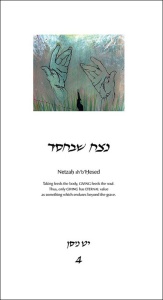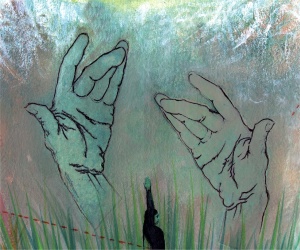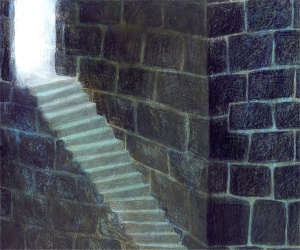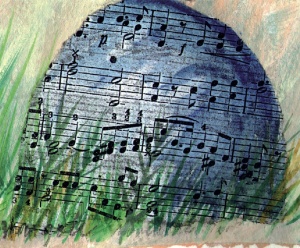Learning to Count: Omer Counter by Judith Margolis
I am still counting. But when you, dear reader, see this, you will have finished, having safely arrived at Matan Torah. Nonetheless, even if you meditated deeply each and every day, the fact is that we still need to count, and ponder the myriad paths of spiritual elevation that Hashem continues to offer us. If we could just become a bit more aware of them. Judith Margolis’ Omer Counter, currently exhibited at Hebrew Union College Museum, offers a visual and textual guide into these riches.


This very special Omer counter is a limited edition book of 50 giclee (fine art digital) prints, hand-bound in such a way that every page can be individually displayed. Each page is numbered by the Hebrew date of counting and features an image by Judith Margolis with the text that inspired them. The text is by Jerusalem-based teacher Sarah Yuhudit Schneider, and explores the seven lower emanations found in the Sefirot, from hesed to malkhut. In turn, each weekday is modified by one of these seven middot, setting up a creative tension between the fundamental aspect of the week and its daily modification. The result: the written meditation and the images guide us through exercises in spiritual and ethical behavior, facilitating our deepening connection with God through the Sefirot. Like all good art, these pages require study and contemplation in order to allow their fruits to ripen. It is rewarding journey.
Let me count the ways…
Margolis utilizes many different motifs to shape her meanings, deftly combining abstract compositions with figurative symbolic touches. Repeated throughout the 49 are images of hands, branches, rooted trees, fiery orbs and, perhaps most evocatively, snakes. Each exudes a symbolic meaning that colors the daily sefirah designation and the accompanying daily kavanah. Day One is Hesed sh’b’Hesed and we see two open hands, equally expressing supplication and giving, as they are cupping a Divine fire. The first meditation focuses on unconditional generosity, “the root of all 49 emotional states.” This is the highest of the emanations, closest to the Divine and yet, only the beginning of our journey.
Day Four, Netzah sh’b’Hesed depicts two hands in a poetic dance of “eternal giving’ that feeds the soul. The notion of hesed, kindness and generosity, sets the tenor of our introspections. Still within the first week on Day Six we arrive at Yesod sh’b’Hesed, uncovering the foundation upon which all our actions should rely. “Giving is the most potent gesture of imitating God. It links the Heavens with the Earth.” Suddenly the two oblong circles of blue, just touching and incised with white, the waters above and the waters below, take on a monumental meaning. What we do down here affects the Divine. I must guard my action, my thoughts, and my intentions.

In the second week, the awesome aspect of gevura dominates and we see Margolis’ images creatively completing the sefirah meditations. On Day Twelve, Hod sh’b’Gevura, speaks of the Fear of God as “I take upon myself the yoke of Torah and mitzvoth.” Each moment “my entire being agrees to place God’s will before my own.” Her image of stair leading up out of an underground stone prison brilliantly expresses the demand that we free ourselves from the captivity of our petty selves, our narrow egos.
Judith Margolis is a painter, as well as a graphic and book artist based in Israel. Her work has been widely published and over a 30-year career she has created many art books and works on paper. Her work has examined the myriad aspect of living as an Orthodox feminist, frequently merging the sacred themes with secular experiences, attempting to understand her place and role in an increasingly complex society. It is perhaps this attachment with complexity that has so well prepared her to deal with the shifting sands of the Omer counting and the daily Sefirot.
As I explore the days of the Omer through Margolis’ book I realize that I have entered a dual universe. Suddenly the specifics of language and its ability to conjure complex ideas with a single word are combined with the specifics of image and its peculiar ability to summon equally complex and specific emotions and ideas. In this arena it’s hard to say which is more poetic and which is more specifically ethical. Each page demands that we take text and image equally seriously, producing a powerful experience.

Each of the seven weeks provides us with a universe of encounters with aspects of God’s wisdom. Day Sixteen, Gevura sh’b’Tiferet, speaks of the need to balance opposing tendencies, generosity (as beauty) and strength with limits and controls. “The gevura of mercy is the quality of self-limitation and self-denial…” The image further complicates our understanding, showing a field bursting forth sprouts beneath an awesome starry sky, infinity soaring above, even a snake winds its way through the plants. Nature’s beauty is tempered, even sullied, by the threat of limitation and compromise. And yet this is the way the Creator made our world.

In many of Margolis’ images there is a darker side, at once reflecting the meditations and yet going further. On day Thirty-seven, Gevura sh’b’Yesod, Schneider writes, “Fear of God is the Foundation of Divine Service” and concludes “this is the Service of Fear and in this way I rest my spiritual striving on solid ground.” In the image we are back down in the stone lined prison cell, the bottom of the stairs now just visible. But the snake has grown, its evil tongue darting forth, guided by a very human hand. Sin crouches always at our door; God’s gift is a foundation of fear. There may be no other way.
In the final week we arrive at malkhut, the Divine emanation closest to mundane existence, the Shekinah. On Day Forty-three, Hesed sh’b’Malkhut, we meditate on the paradox of God’s simultaneously Giving, as we open ourselves up to Receiving. “The solution is to know that our joyful Appreciation of Hashem’s gifts is itself the greatest offering that we give back to our Creator.” The image literally sings musical notes of joy in a field of color bursting in appreciation. We have arrived at a graspable wisdom, an action we can do to finally fully join in the Divine symphony of creation.
Judith Margolis’ Omer Counter exists in a wonderful contradiction. It is designed to guide us through the 49 days between the freedom of Passover and the acceptance of Torah at Shavuot, effectively creating 49 steps up to the heights of Sinai. And yet, the meditations and images are a paradoxical descent down from spiritual heights of hesed to the earthly reality of malkhut, the realm of the Divine Presence that directly touches our world. Once we grasp this contradiction we immediately see that these 49 steps are not limited by time or, for that matter, by direction. The mapping of the Sefirot, an impossible image of Divine emanations, present their wisdom outside the limitations of time, and in fact are only limited by our spiritual wisdom and imagination. If we would just become a bit more aware. This artwork pushes us in exactly that direction.
Learning to Count
Omer Counter by Judith Margolis
Published by www.brightideabooks.com
Hebrew Union Collage – Jewish Institute of Religion Museum
One West 4th Street, New York, NY 10012; 212 824 2205
Mon. – Thurs. 9am – 5pm; Friday, 9am – 3pm.
Free Admission (Photo ID required)